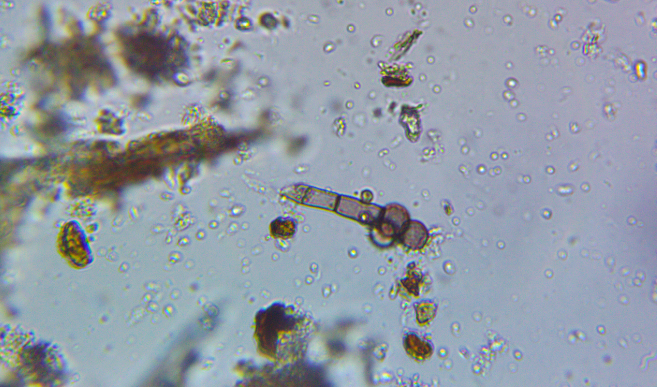Rethinking Weeds: Part 2, What Is That Weed Doing?
When we see weeds as symptoms, They can help us find the root of the problem. So what Disease are our weeds fighting?
Just when we think we humans have truly screwed something up, Nature laughs and brings in something to clean up the mess. Take the nuclear disaster at Chernobyl, sunflowers were successfully used to remediate the soil by mopping up toxic levels of Cadmium and Cesium. Last time we talked about the Lanceleaf Ragweed on the ranch and how nature uses weeds to solve problems. Just like a fever is the body’s way of fighting illness, a weed is doing a job of healing the soil. So what is the Lanceleaf Ragweed doing on the ranch? What problem might it be trying to fix? Weeds fix a host of problems:
Bare ground
You can think of bare soil like an open wound and those early succession weeds, a bandaid. Soil that isn’t covered is subject to all manner of temperature swings and evaporation which harms our soil microbiome.
I don’t think this is what’s causing our Lanceleaf issue. We have good soil cover from our native grasses, the lanceleaf is just growing throughout the grass.
The view looking across the paddock. The skeletons of the prior year’s lanceleaf ragweed are scattered throughout the grasses, but is not a solid stand.
Always be sure to look straight down when assessing ground cover! We have excellent ground cover from the native grass and leaf litter
Low Organic Matter
Organic matter is like a sponge for water and nutrients and it serves as a food source for soil microbes. What is considered low? At a minimum we want to see 3% OM, however this number changes with latitude.
On the ranch, our soils range from 6-8% organic matter, which is a far cry higher than many croplands in our area. What would those numbers have been historically? How has different grazing management changed this? I think it’s fair to say that our soil could still be improving, but I would say the organic matter is pretty good, probably not the cause of our lanceleaf issue.
Compacted Soil
A compacted soil is a suffocating soil. We need adequate air in our soil to allow water infiltration and retention, nutrient cycling, and of course, keep our soil microbes alive! The best way to assess this? Dig a hole! We found our soils are tighter on the uplands, however, when we looked at the root system of the Lanceleaf, the root system is a thin tap root. Could it be breaking up compaction? If you think a weed is showing up due to compaction take a look at it’s root system. Is it a deep tap root? A fibrous root? Are the roots growing straight down or do they grow sideways when they hit a compaction zone?
Dig a hole! Our soil structure is a little tighter and blockier
The root system of a dead Lanceleaf Ragweed has a thin taproot
Microbial Imbalances
That’s right, microbes. I bet you weren’t expecting that ; ) The interactions between microbes and plants are a fascinating subject and one we’re still learning about. But here are some key takeaways from what we know right now:
Functional Groups - Having all functional groups of microbes (Bacteria, Fungi, Protozoa, Nematodes) are key for plant productivity.
Fungi: Bacteria - Plants are most productive when the amount of fungi and bacteria are in balance. This balance shifts depending on the plant type. For a Tallgrass prairie, we want that balance to be 1:1 in terms of biomass.
For our Lanceleaf, we do notice some functional groups missing, nematodes are a bit scarce, and our F:B is around 0.2:1 which is pretty low from our 1:1 goal. This could be a clue to what is driving this lanceleaf ragweed.
A nice strand of fungal hyphae with spores
Mineral Imbalances
Some plants are suited for taking up trace minerals. When those minerals are low in our soil, the weeds have a competitive advantage over our desired plants. We can assess this by comparing soil and plant tissue tests. When we look at our tissue tests we see:
Low levels of Phosphorus, Copper, Sulfur, and Boron
Potentially low levels of Calcium and Zinc
These low levels in the leaf tissue tell us that we have an uptake issue in the plant. It could be due to low microbial numbers. For example, Calcium can be high in the soil, but if we don’t have adequate fungi we decrease our plant’s ability to uptake it. High levels of other nutrients can also decrease the plant’s uptake of other nutrients. For example, high levels of Calcium can affect several other nutrients like Magnesium, Potassium, Boron, Zinc, Manganese, Iron, and Phosphorus.
Some mineral imbalances that we see could be due to past grazing management. With the improvements in management over the last several years we’ll hopefully shift in the right direction. In the meantime, this also poses the question, are the cattle getting all the minerals they need? The cattle on the ranch are well taken care of and have access to salt and mineral, but some trace minerals such as Boron aren’t generally included in cattle mineral since it’s not considered essential. However recent research is showing that Boron is an important mineral for plants and animals.
Toxins
Like the sunflowers at Chernobyl, some weeds take up heavy metals, nitrates, and other toxins and turn them into a safer form for the soil.
Is this happening in our soil? In this particular site, we don’t have any major reasons to assume heavy metals. There’s still microbial activity and healthy plant communities. If we were using fertilizers or if we noticed no microbes when we peek under a microscope then I might be a little more concerned about this.
We’re starting to see some potential causes of our Lanceleaf Ragweed with microbial and potential mineral imbalances. So what do we do about this? We’ll talk about this in the next blog!







